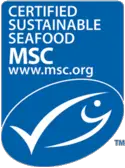Tuna is the household name for the 15 species of saltwater fish belonging to the Thunnini tribe, the largest members of the Mackerel family.
Albacore, Southern Bluefin, Bigeye, Pacific Bluefin, and Atlantic Bluefin tuna are all part of the bluefin group; Blackfin, Longtail, and Yellowfin tuna belong to the yellowfin group.
Together, these two groups are known as the “true tunas.”
The fattier, more flavorful, and higher-priced tuna fish in the bluefin group are used mainly for sushi or steak. The leaner, milder-flavored, and more affordable fish in the yellowfin group are typically canned.
But it’s their cousin, the Skipjack tuna, that gets the lion’s share of the market. Fishing trip site FishingBooker reports that Skipjack tuna makes up as much as 70% of the canned tuna sold on an annual basis in the United States.
Go shopping for canned tuna in the canned fish aisle, and you’ll find yourself in muddy waters: most grocery stores carry a dozen or so brands, each offering at least a few varieties.
Of course, when you read into the labels, they all claim to be no. one!
Which ones should you reach for?
Here’s how to read—and decode—the terms and claims that producers put on canned tuna labels so that you can make the best choice, even when the variety is overwhelming.
Light Tuna vs. White Tuna
Producers use the terms “light tuna” and “white tuna” to differentiate between two kinds of tuna that sport a unique texture, color, and taste.
“Light tuna” usually refers to Skipjack or Yellowfin tuna. Skipjack tuna is dark-red and potently fishy, whereas yellowfin tuna is pale-pink and mild-flavored. Both Skipjack and Yellowfin tuna are lean, affordable, and low in mercury; select whichever you and your household like more.
“White tuna,” on the other hand, generally refers to Albacore tuna. Fatty, flavorful, and expensive, Albacore tuna has a white to light-pink color and a barely-noticeable taste of fish that slightly resembles chicken.
When in doubt, go for light tuna: it’s not only more affordably priced, but it also has less of the heavy metal mercury.
Though white tuna is considered (and marketed as) a delicacy, it also tends to contain more mercury than light tuna because the fish are bigger and more mature.
Tuna in Oil, Brine, or Springwater
Oil-packed tuna can be preserved in sunflower, soybean, or olive oil. Sunflower oil and soybean oil are the cheaper, lesser-flavorful options compared to olive oil. This type of tuna is more caloric but flavorsome. For the best product, look for tuna canned solely with extra virgin olive oil.
Brined tuna is preserved in generously salted water. The brine brings out the flavor and makes the fish more tender. However, it also increases the amount of sodium contained in the can. So avoid it if you need to mind your salt intake.
By far, my two favorites are extra virgin olive oil-packed tuna and springwater-packed tuna.
Springwater tuna contains fewer calories and no additives. One study found that it’s also three times richer in Omega-3 fatty acids compared to brined and oil-packed tuna. So it’s no wonder why it’s widely considered to be the best and most natural choice.
Solid, Flake, or Chunk Tuna
Depending on the cut, canned tuna can be solid, flake, or chunk. What’s the difference?
Solid tuna is a whole cut of tuna squeezed into a can, flake tuna is consists of flaky pieces of tuna, and chunk tuna are the tiny leftovers of all sizes. Solid tuna is the most expensive, flake tuna is the middle range, and chunk tuna is the cheapest.
More often than not, flake tuna offers the best price/quality ratio. I find solid tuna to be a little too pricey, and chunk tuna to be too leftoverish.
Wild-Caught Tuna
Checking the cans of tuna out one by one, you’ll often come across the term “wild-caught tuna.” This is a fancy way for producers to say that the fish was caught from the ocean—and not farmed.
Farm-raised tuna can be fed unnatural foods and given antibiotics, which is why it’s perceived to be of lesser quality than wild-caught tuna. Still, not all wild-caught tuna is… caught equal.
Wild fishing has its fair share of problems, like bycatch and overfishing.
The best thing to do is look for wild-caught, pole-and-line caught fish with at least one of the two certification seals explained below.
Pole and Line Caught Tuna
If you’re keen on sustainability, you know that every purchase you make as a consumer matters. So you want to pick a can of tuna that says “pole and line” somewhere on the label.
Pole-and-line fishing is a term for the same old fishing method that people have used to get their food from the sea for thousands of years. It’s costlier but helps keep small-scale fishermen’s businesses afloat and prevents overfishing in the grand scheme of things.
Certification Labels
When it comes to sustainability, it’s not always wise to take producers for their word. That’s there certification labels from independent organizations that verify tuna quality and fishery sustainability come into play.
Certified Sustainable Seafood by MSC

Look for cans with third-party certification, the most reliable of which is the Marine Stewardship Council’s (MSC’s) “Certified Sustainable Seafood” seal.
The Marine Stewardship Council is an independent non-profit organization that, according to FoodPrint, offers the most rigorous certification programs for fisheries and is considered to be “the gold standard of sustainability.”
Fair-Trade Certified by Fair Trade

The “Fair-Trade Certified” seal by non-profit organization Fair Trade USA means that the tuna in the can was fished sustainably and packaged in a safe working environment.
Since the 1980s, when globalization came knocking on the door of the canned tuna industry, most canned tuna is sourced from fisheries in Southeast Asia, especially Thailand.
Given that these fisheries are not known for the most sustainable practices or best working conditions, this seal helps you ensure you’re buying from businesses that act responsibly and play by the rules.

